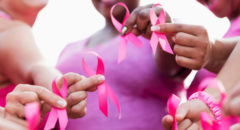
If the title surprised you, you’re not alone.
In fact, many Black men are going through life never even considering that breast cancer could be a possibility. Unfortunately, this is not the case. According to the American Cancer Society, roughly 1 in 830 Black men will be diagnosed with breast cancer during their lifetime, or about 0.13 percent.
Although this may sound like a minimal risk, the truth is a little more complicated. Because breast cancer among men is uncommon, it often goes undetected or misdiagnosed. Many Black men may simply dismiss the symptoms as something else.
But this is nothing to wave away. In fact, Black men have a higher incidence rate than most other races, making them the most susceptible to poor outcomes. This is why understanding the unique presentations of the disease is so crucial.
Let’s discuss four symptoms to be mindful of, and most importantly, what you can do.
1. Gynecomastia-like Symptoms
Gynecomastia is a term that means enlargement of breast tissue in men. While breast cancer does not specifically cause gynecomastia, it does lead to very similar changes. Black men who experience growing breast tissue may also have the condition due to hormone changes, medication side effects, and other health conditions.
This is why it’s important to be vigilant.
In Black men, gynecomastia can mean more than just a benign tissue enlargement. Sometimes the breast enlargement feels firm, with obvious masses. If you’re looking in the mirror, and one breast clearly looks larger than the other and feels differently, don’t just wave it away.
Consider consulting a physician as soon as possible. At the very least, you can get an examination and narrow down potential causes and treatments. Early detection always beats late detection!
RELATED: Black Men Get Breast Cancer Too: 3 Signs You Should Know
2. Nipple Discharge
While rather unpleasant to think about, this occurs for many reasons. Sometimes, it’s due to medications such as antidepressants, blood pressure drugs, and sedatives. It can also be due to an infection, but in rare cases, it could be due to breast cancer.
When it’s breast cancer, you may notice that it only happens to one breast. The fluid too may vary, but in more severe cases, may go from clear or even colored to outright bloody.
If you notice any discharge, of any kind, do not delay. Seek medication attention as soon as you can, especially if the discharge occurs without you applying pressure. If the nipple’s appearance has changed too, this is even more reason to see a doctor.
Imaging tests and other exam tools can help determine what is going on.
3. Skin Erosion
A type of physical change, skin erosion is essentially the loss or disturbance of flesh. In other words, symptoms like redness, scales, or even ulcers of your breast or nipple. In Black sufferers, the presentation can be different. Due to the skin pigmentation difference, it may be more difficult to detect skin erosion. In other cases, skin erosion may be significantly more pronounced, making it an embarrassing and unsightly issue.
If you notice skin erosion, speak to a dermatologist or general practitioner as soon as you can. In some cases, invasive breast tissue is the factor at play. If left untreated, skin lesions may become apparent, making it even more difficult to diagnose and treat.
Fortunately, a comprehensive examination – often with a biopsy – can get to the bottom of the issue quickly.
4. Increased, More Frequent Pain
In women, pain in the breast is less common during cancer. With men, however, localized pain and discomfort are significantly more prevalent. While the exact reasons are unknown, it likely has to do with the breastplate and musculature of the male body. Differences in tissue distribution may also be to blame.
Whatever the precise reasons, one thing is for sure: Black men, especially, report more pain and discomfort with breast cancer.
Consider the symptoms. Is the pain persistent? Does it hurt to the touch, feel hot, or cause other sensations?
While many cases of breast pain in men may be attributed to muscle soreness, some are more serious. If the pain and discomfort don’t go away, it’s always a good idea to contact a doctor just to be safe.
Overall, it’s always important to contact a doctor when unexplained symptoms persist. Although breast cancer in Black men may be rare, it does occur, and because it’s rare, that often complicates diagnoses and treatments. Not to mention, stereotypes about the disease.
But that can change. Hopefully, by being more open and honest about breast cancer in Black men, we can defeat the stigma and help them get the proper medical attention they deserve.









